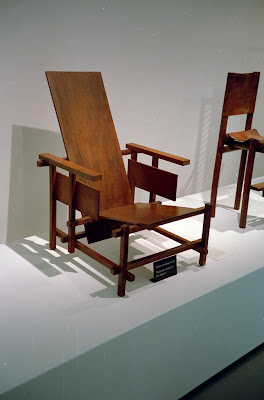 So apparently he was banging around on this kind of dowel-based composition in lines and planes before he hit upon the Mondrian palette more typically associated with this chair.
So apparently he was banging around on this kind of dowel-based composition in lines and planes before he hit upon the Mondrian palette more typically associated with this chair.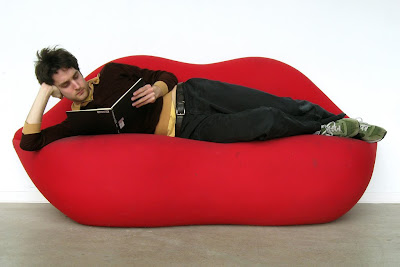 The Marilyn Sofa, or the "Lip Chair" as it's almost inevitably known, is another awkward entry in the Student Lounge. Clearly the idea of evoking whimsy, fun, and a certain sauciness all make sense for the program at hand, and the saturated color is a hit with me and others who appreciate any attempt to play off of Knowlton's ubiquitous greyness.
The Marilyn Sofa, or the "Lip Chair" as it's almost inevitably known, is another awkward entry in the Student Lounge. Clearly the idea of evoking whimsy, fun, and a certain sauciness all make sense for the program at hand, and the saturated color is a hit with me and others who appreciate any attempt to play off of Knowlton's ubiquitous greyness.It's unfortunate, then, that the thing is so useless. Its Baroque plan - curving in and out several times throughout its length - make sleeping completely absurd for all but the tiniest of architecture students. Even sprawling out to do a little afternoon reading isn't really all that viable. As for plain old sitting, forget it - the upper lip pushes into the small of your back, but in a way too irregular (it, too, is curving) to offer lumbar support.
Also, I don't personally care, but a lot of people are just put off by the lip motif generally; some other contingent doesn't mind lips, but is disturbed by the staining/dirtiness/wear-and-tear of these particular lips.
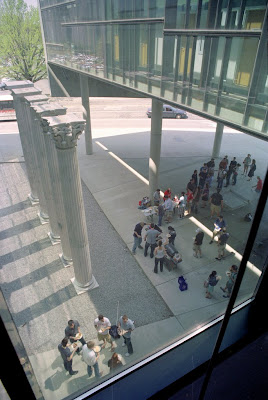
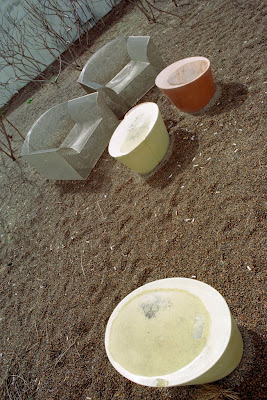
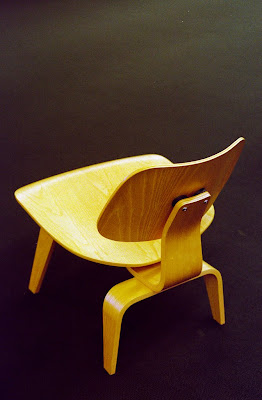 The Lounge Chair Wood actually ranks its own Wikipedia Entry; it's significant not only as the breakthrough production-ready design from the Eames studio, but also as the first complexly-curved molded plywood furniture design by anybody.
The Lounge Chair Wood actually ranks its own Wikipedia Entry; it's significant not only as the breakthrough production-ready design from the Eames studio, but also as the first complexly-curved molded plywood furniture design by anybody.The Eameses had been working on the problem for quite some time; with Eero Saarinen, they won the MOMA Organic Furniture competition back in 1940. They ran into trouble trying to actually realize mass-producible versions of their designs. The shortages and demands of World War II thankfully drew the project to a close before it could become really embarrassing, and during the war Charles and Ray perfected a means of molding plywood (originally experimenting, in their apartment, with a contraption that used a bicycle pump to provide the needed pressure).
Designing the chair around the capabilities of the technique (rather than hoping that techniques would catch up with the design) they scrapped the original dream of a single curving piece that would accommodate both seat and back. This ambition would be eventually realized when they discovered fiberglass - but in the meantime, there was the LCW.
(For more on this story, I strongly recommend An Eames Primer by Eames Demetrios.)
So how is it as a chair? I find it supremely comfortable, surprisingly so for a wooden thing with no upholstery whatsoever. Partly it's the curvature, and partly it's the rubber "shock mount" design for attaching the back to the seat - this thing has a little bit of give to it. It is, however, ill-suited as library furniture; like many of the other items in the KSA collection, it seems intended for cocktail conversation and, well, lounging. Without armrests, and set at a height that makes resting one's elbows on a table unlikely, it's just not cut out for reading in. But just as a thing to sit in, it's one of my favorites, and I've occasionally stuck it in project renderings just to amuse myself.
No comments:
Post a Comment